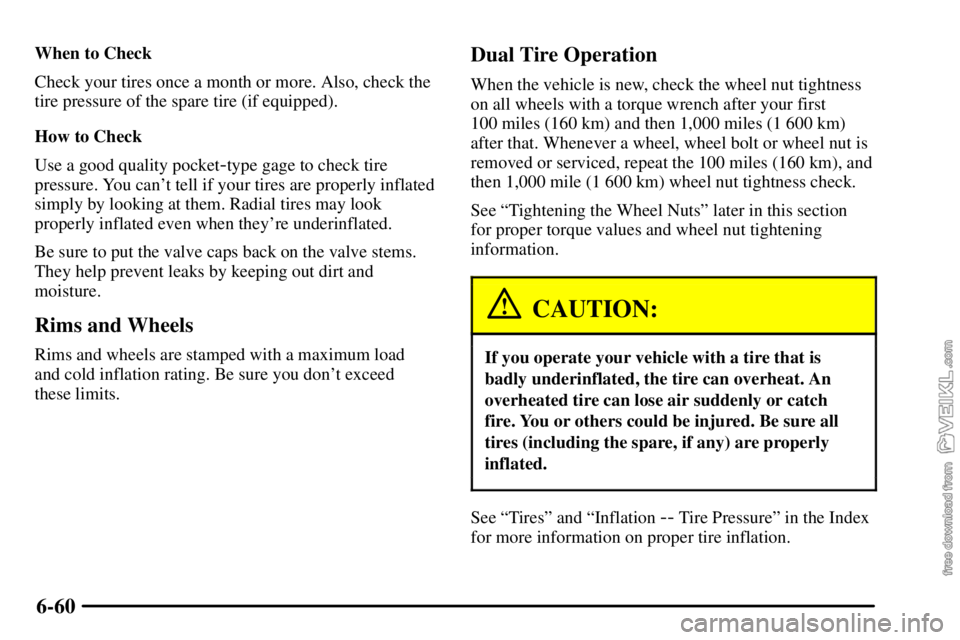Page 223 of 386
4-30
If you have a diesel engine, you may have to run it at a
higher speed to get enough heat. Then, shut the engine
off and close the window almost all the way to preserve
the heat. Start the engine again and repeat this only
when you feel really uncomfortable from the cold. But
do it as little as possible. Preserve the fuel as long as you
can. To help keep warm, you can get out of the vehicle
and do some fairly vigorous exercises every half hour or
so until help comes.Loading Your Vehicle
There is a GVW Rating label on your vehicle that shows
how much weight it may properly carry. It also shows
the size of your original tires and the inflation pressures
needed to obtain the gross weight capacity of your
vehicle. This is called the Gross Vehicle Weight
Rating (GVWR).
Page 313 of 386
6-59 Inflation -- Tire Pressure
The GVW Rating label, which is on the driver's door,
shows the correct inflation pressures for your tires
when they're cold. ªColdº means your vehicle has
been sitting for at least three hours or driven no more
than 1 mile (1.6 km).
NOTICE:
Don't let anyone tell you that underinflation or
overinflation is all right. It's not. If your tires
don't have enough air (underinflation), you can
get the following:
�Too much flexing
�Too much heat
�Tire overloading
�Bad wear
�Bad handling
�Bad fuel economy
NOTICE: (Continued)
NOTICE: (Continued)
If your tires have too much air (overinflation),
you can get the following:
�Unusual wear
�Bad handling
�Rough ride
�Needless damage from road hazards
Page 314 of 386

6-60
When to Check
Check your tires once a month or more. Also, check the
tire pressure of the spare tire (if equipped).
How to Check
Use a good quality pocket
-type gage to check tire
pressure. You can't tell if your tires are properly inflated
simply by looking at them. Radial tires may look
properly inflated even when they're underinflated.
Be sure to put the valve caps back on the valve stems.
They help prevent leaks by keeping out dirt and
moisture.
Rims and Wheels
Rims and wheels are stamped with a maximum load
and cold inflation rating. Be sure you don't exceed
these limits.
Dual Tire Operation
When the vehicle is new, check the wheel nut tightness
on all wheels with a torque wrench after your first
100 miles (160 km) and then 1,000 miles (1 600 km)
after that. Whenever a wheel, wheel bolt or wheel nut is
removed or serviced, repeat the 100 miles (160 km), and
then 1,000 mile (1 600 km) wheel nut tightness check.
See ªTightening the Wheel Nutsº later in this section
for proper torque values and wheel nut tightening
information.
CAUTION:
If you operate your vehicle with a tire that is
badly underinflated, the tire can overheat. An
overheated tire can lose air suddenly or catch
fire. You or others could be injured. Be sure all
tires (including the spare, if any) are properly
inflated.
See ªTiresº and ªInflation -- Tire Pressureº in the Index
for more information on proper tire inflation.
Page 320 of 386

6-66 Wheel Replacement
Replace any wheel that is bent, cracked or badly rusted.
If wheel nuts keep coming loose, replace the wheel. If
the wheel leaks air, replace it.
Your dealer will know the kind of wheel you need.
CAUTION:
A leaking wheel could fail without warning. A
wheel designed for tubeless tires could be leaking
because it is damaged. Don't use an inner tube or
some other thing to try to stop the leaking. Get a
new wheel of the proper type.
CAUTION:
Without the correct wheel, you may not be able
to stop properly, and you could have other
problems like a tire air
-out. You could have a
collision. If you don't go to your dealer to get a
new wheel, be sure you get the correct one. Each
new wheel should match the original wheel in
load
-carrying capacity, inflation pressure
capacity, diameter, width, offset and mounting
configuration.
Using wheels and tires with higher load-carrying limits
than the original wheels and tires doesn't change the
GAWR or the GVWR of your vehicle.
Page 367 of 386

7-21
Part B: Owner Checks and Services
Listed in this part are owner checks and services which
should be performed at the intervals specified to help
ensure the safety, dependability and emission control
performance of your vehicle.
For your safety and that of others, any of the
safety
-related components that may have been damaged
in an accident should be checked and any needed repairs
made before operating the vehicle.
At the minimum, these routine checks should be made
every 6 months or 6,000 miles (10 000 km), whichever
occurs first. Whenever repairs are needed, have them
completed before operating the vehicle.
At Each Fuel Fill
It is important for you or a service station attendant to
perform these underhood checks at each fuel fill.Engine Oil Level Check
Check the engine oil level and add the proper oil
if necessary. See ªEngine Oilº in the Index for
further details.
Engine Coolant Level Check
Check the engine coolant level and add DEX
-COOL�
coolant mixture if necessary. See ªEngine Coolantº in
the Index for further details.
Windshield Washer Fluid Level Check
Check the windshield washer fluid level in the
windshield washer tank and add the proper fluid if
necessary. See ªWindshield Washer Fluidº in the Index
for further details.
Tire Inflation Check
Check tire inflation cold. Make sure tires are inflated to
the pressures specified on the GVW Rating label. See
ªLoading Your Vehicleº and ªTiresº in the Index for
further details.